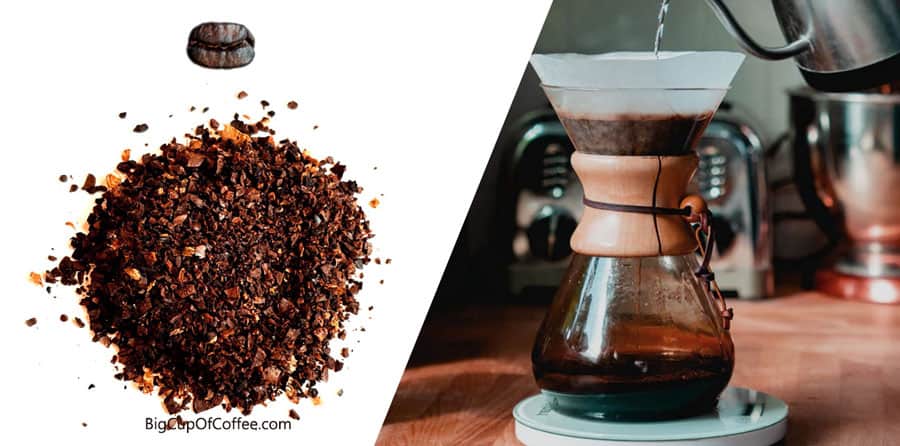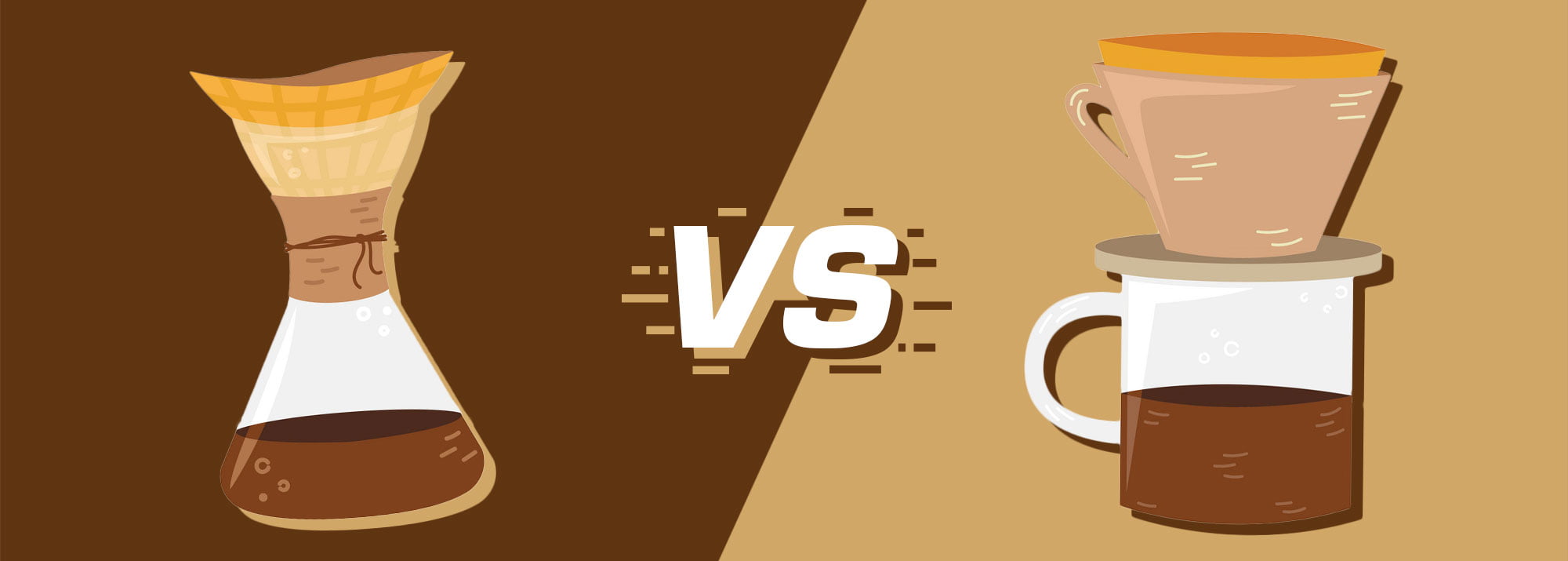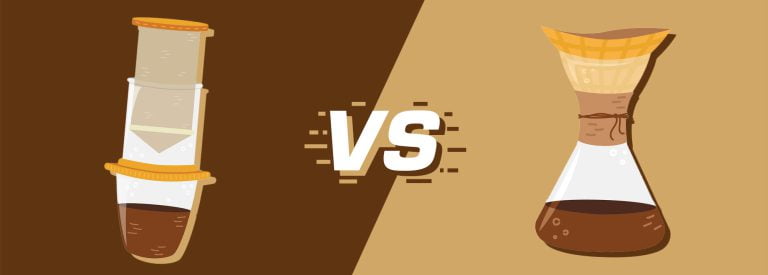Chemex vs Pour Over: Are They The Same?
There are a lot of ways to brew coffee and for the newbies, it might get overwhelming. One common question I often get is: Which is better, Chemex or pour over?
Well, the answer might surprise you.
Comparing Chemex & Pour Over
So what sets Chemex and pour-over apart? The truth is that Chemex is a pour over method. Pour over involves pouring hot water gradually over medium-fine ground beans in your chosen coffee maker. The water that flows into the coffee bed will then turn into coffee that drips down to your decanter.
Popular pour over coffee makers include the Hario V60, Kalita Wave, and the Chemex itself. What makes the Chemex different from the others is its hourglass-shaped borosilicate glass construction that combines the dripper and decanter into one.
Here are the factors to consider when picking your pour over coffee maker and help you decide if Chemex is right for you:
| Features | Chemex | Pour Over in General |
|---|---|---|
| Taste & Flavor | Clean, light, with a hint of sweetness | Clean, complex, light body |
| Strength | Medium, adjustable | Adjustable |
| Ease of Use | Easy, small learning curve | Easy, small learning curve |
| Brewing Speed | 5-7 minutes | 5-7 minutes |
| Versatility | Four capacity options: 3-cup, 6-cup, 8-cup, 10-cup | Depends on brewer |
| Durability & Portability | Least durable and portable | Various options with different materials |
| Sustainability | Compostable filters, glass and wood construction | Eco-friendly, compostable filters, reusable options |
| Cost | $40-$60 | $10-$60 |
Taste, Flavor, & Strength
Generally, the coffee produced by pour over methods are clean and complex with a light body. You can alter its strength by adjusting the coffee-to-water ratio or using different roast levels.
Chemex specifically, enjoys the same clean and light result with a commonly medium strength that you can modify to your liking. What makes it stand out though is that it has a hint of sweetness that can be attributed to its thicker paper filter.
So is Chemex right for you based on the flavor and strength? I personally recommend that you try it out first to find out. For me, while it produces a smooth drink, it offers complexity in each cup that I really appreciate.
You might also want to read this article to compare Chemex with Hario V60.
Ease of Use
Now let’s discuss how easy this brewing method is. Pour over in general isn’t difficult but it requires a small learning curve for you to get your timings and pouring technique right. To achieve this, you usually use a gooseneck kettle to pour hot water (195°F to 205°F) over the medium-fine coffee grounds.
The small learning curve also applies to Chemex when you’re making coffee, except that you’d want to lean toward a medium-coarse grind size while the water temperature must be around 200°F for optimal results.

Of the different manual brewers that I have tried, the Chemex is one of the easiest methods to get used to, and I think you’ll be enjoying your coffee with it in no time.
Brewing Speed
In terms of pour over’s speed, these methods are not the fastest, often taking 5 to 7 minutes from grinding to brewing and cleaning up – Chemex included. It often requires some 30-second blooming which involves pre-wetting the coffee grounds before pouring in the rest of the water for an even extraction.
Compared to drippers like the Hario V60, however, Chemex takes some extra time and effort when cleaning up because it has a bigger body that’s also more fragile.
Overall, this brewer, and pour overs in general have decent brewing speeds. The Chemex is not as fast as the AeroPress, but it has a slight edge over the French press and a wider lead over the Moka pot.
Versatility
In terms of versatility, pour over methods are known to provide a high degree of control over the brewing process. The factors you can modify include water temperature, flow rate, grind size, and the coffee-to-water ratio which ultimately determine its extraction of flavors and aromas.
The Chemex has an advantage in its flexibility in sizes. Compared to the V60, which only comes in three sizes, Chemex has four capacity options you can choose from to really cater to your specific needs:
- 3-cup (16 oz)
- 6-cup (30 oz)
- 8-cup (40 oz)
- 10-cup (50 oz)

Durability and Portability
If you’re always on the go, or you know you can be a bit clumsy at times, then you’d want a brewer that’s both durable and portable.
Pour over methods often come in a variety of materials with varying degrees of durability and portability. Drippers like the V60 are available in different sizes and materials:
- Metal
- Copper
- Plastic
- Ceramic
- Glass

In contrast, the Chemex is the least durable and portable pour over brewer. It has a glass body that can break, so despite its compact size, I wouldn’t risk packing it inside my bag if I need a coffee maker with me when I’m heading out.

Sustainability
It is also important to consider sustainability when you’re making coffee, to make sure that it doesn’t leave any significant harm to the environment.
Being manual brewers, pour over methods do not consume electricity making them generally eco-friendly brewers. While they use paper filters, Chemex and V60’s own filters are compostable. You can also opt for reusable options such as metal and cloth filters.
The classic Chemex is also made with glass and wood which makes it more sustainable when compared to drippers that have plastic variants or parts. So if you want a pour over brewer that minimizes your carbon footprint, then Chemex might just be your best pick.
Cost
In terms of prices, where does the Chemex lie among the other brewing devices out there?
The Chemex is reasonably priced ranging from $40 and up to $60. In addition to the coffee maker itself, paper filters can set you back $0.16 per piece (2025) every time you make coffee.
Chemex is generally pricier than the V60 which ranges from $10 to $50, as well as other manual coffee makers such as the AeroPress and French press. Still, I think that the Chemex offers great value for money so if you have the extra bucks, investing in one is definitely worth considering.
You also need to consider that making coffee with a pour-over brewer requires extra accessories:
- coffee scale
- gooseneck kettle
- burr grinder
Compared to Other Brewing Methods
You can also find out how the Chemex fares compared to other brewers including:
Meanwhile, here are my comparisons between pour over and other brewing methods:
Conclusion
To sum it all up, the Chemex is a well-known pour over coffee making method. Compared to other pour over brewers, the Chemex stands out due to its beautiful glass body, flexibility in size, and thicker filters which result in a unique brew with a hint of sweetness.
Personally, I love using my Chemex because of its versatility and its elegant design that lets you brew with style. I don’t use it often though, which may be the reason I haven’t broken it yet 🙂
How about you, does the Chemex fit your needs and cravings? I’d like to know so feel free to share it in the comments below.







